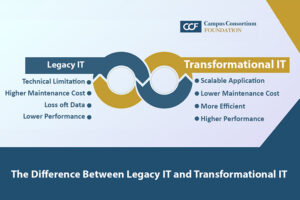The pandemic not only exposed the stark deficiencies in technological advancement within higher education institutions but also served as a catalytic force, rapidly accelerating the need for transformative change across the entire education landscape. The unprecedented global crisis highlighted not just the vulnerabilities of traditional education models but also the urgency for institutions to adapt and innovate to meet the evolving needs of students and society at large.
Change is required for higher education to be sustainable, and it takes a collective commitment across the entire institution.
Educational institutions resist change but need it now more than ever.
Change is imperative.
The legacy methods, processes, and procedures that dominated the golden age of higher education are not sustainable in today’s education environment, making change not only necessary but required. Change allows institutions to explore new programs and engage students differently. Change encourages growth and ensures an educational institution is relevant and an asset to society. To find relevance and growth means moving outside of an institution’s comfort zone and challenging the status quo that may be holding back growth. New perspectives and approaches can unlock plentiful opportunities to create a stronger institution and improve the path to the future. Change makes an institution flexible and adaptable, developing an ability to embrace challenges and opportunities that may never have been achievable. Change builds institutional confidence and preparedness at all levels, creating an organization ready to adapt and flourish.

Change is disruptive.
Change in any organization is disruptive. For educational institutions, it disturbs the status quo and can trigger emotional responses from employees. Education’s open and democratic environment is known to be “slow to change.” Lack of resources, funding, and time also impact the ability to make changes.
Change impacts procedures and processes and causes internal resistance that ultimately decreases the value and efficacy of change investments. Significant change cannot be implemented in educational institutions until the forces for change are greater than the forces preserving the status quo. For colleges and universities, the forces for resisting change are extremely powerful:

Change Reactions
World-renowned psychiatrist and researcher Elisabeth Kübler-Ross developed the Kübler-Ross’ Change Curve Model, depicting five stages of grief: denial, anger, bargaining, depression, and acceptance. She used the Change Curve in her psychiatry practice, but similar stages can be observed in organizational change and transition. Like significant life events, significant work events impact employees. When employees react to change, they experience stages of emotion that affect compliance, productivity, and morale. These reactions can incur expenses, derail projects, interrupt initiatives, and delay implementations.
How to support change effectively
Change Models
The ADKAR model (Awareness, Desire, Knowledge, Ability, and Reinforcement) developed by Jeff Hiatt, the organizational change model by Edgar Schein, and the agile development model are just some of the tools change leaders use to ease transitions of all types. In addition to technology implementations, change leadership assists with layoffs, mergers, automation, and other significant organizational events.
Change Leadership
Change leaders can anticipate these responses by leveraging change models to understand the emotional stages of transition and address human factors to optimize transitions between investment and implementation. Training employees and departments is good but can be ineffective if not combined with the necessary guidance and support for all phases of an initiative. A holistic approach using change leadership principles and practices can save an institution significant time and expense. Change leaders provide human-factor event management services that are critical to success but often unaddressed in project management.
Cultural Acceptance
Cultural acceptance in society emphasizes acceptance of everyone, and DEI (Diversity, Equity, and Inclusion) helps everyone participate in the larger community. Whether an institution initiates a new technology implementation or significantly modifies a business process, cultural acceptance eases and efficiently integrates change into the institution’s structure and community. Communicating, identifying obstacles, recognizing needs, reducing conflict, and building bridges help the campus community relate to and accept change. Hanging leadership reduces judgment, strengthens tolerance, and increases acceptance.
Campus Consortium Foundation is committed to serving the higher education community as a change champion, contact manager, and problem solver to advance education, provide equitable access to technology, and overcome financial, expertise, and resource challenges. Become a member and start your journey today.




